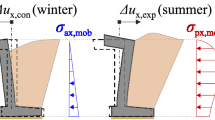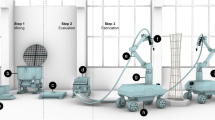Abstract
Expansion and contraction of bridge decks move integral bridge abutments (IABs) toward and away from the backfill, resulting in high horizontal earth pressures, backfill surface settlements, and abutment toe movements away from the backfill. Geofoam can reduce relative abutment movements to the backfill when the abutment moves toward the backfill due to bridge deck expansion. Geosynthetic reinforcement can improve the stability of the backfill, thus reducing backfill surface settlements when the abutment moves away from the backfill due to bridge deck contraction. Numerical analysis was utilized in this study to investigate mechanisms of geosynthetic reinforcement and geofoam and effects of key parameters, such as the thickness and elastic modulus of geofoam and the length and vertical spacing of geosynthetic reinforcement. Increasing the thickness and/or reducing the elastic modulus of geofoam could reduce maximum horizontal earth pressures in the backfill. However, the effects of geofoam to reduce backfill surface settlements were not significant. In addition, geosynthetic reinforcement reduced surface settlements of the backfill away from the abutment but increased surface settlements of the backfill right behind the abutment. By connecting the front ends of geosynthetic reinforcements with the abutment, settlements of reinforced backfill decreased at the expense of large settlements of unreinforced backfill. Furthermore, geofoam together with geosynthetic reinforcement with wrap-around facing could significantly minimize seasonal temperature change-induced problems for IABs.


























Similar content being viewed by others
References
Al-Qarawi A, Leo C, Liyanapathirana DS (2020) Effects of wall movements on performance of integral abutment bridges. Int J Geomech 20(2):04019157. https://doi.org/10.1061/(ASCE)GM.1943-5622.0001559
Al-Qarawi A, Leo C, Liyanapathirana DS, Ekanayake SA (2016) Study on the effects of abutment cyclic movements on the approach of integral abutment bridges. Australn Geomech 51(2):1–13
Athanasopoulos-Zekkos A, Lamote K, Athanasopoulos GA (2012) Use of EPS geofoam compressible inclusions for reducing the earthquake effects on yielding earth retaining structures. Soil Dyn Earthq Eng 41:59–71. https://doi.org/10.1016/j.soildyn.2012.05.004
Cui L, Mitoulis S (2015) DEM analysis of green rubberised backfills towards future smart integral abutment bridges (IABs). Geomech Micro Macro I II:583–588
Damians IP, Bathurst RJ, Olivella S, Lloret A, Josa A (2021) 3D modelling of strip reinforced MSE walls. Acta Geotech 16(3):711–730. https://doi.org/10.1007/s11440-020-01057-w
Horvath JS (1994) Expanded polystyrene (EPS) geofoam: an introduction to material behavior. Geotext Geomembr 13(4):263–280. https://doi.org/10.1016/0266-1144(94)90048-5
Horvath JS (2000) Integral-abutment bridges: problems and innovative solutions using EPS geofoam and other geosynthetics. Res Rpt No CE/GE- 00:2
Horvath JS (2004) Integral-abutment bridges: a complex soil-structure interaction challenge. In: Proceedings of GeoTrans 2004, Los Angeles, CA, pp 460–469. https://doi.org/10.1061/40744(154)31
Itasca (2019). User’s guide for FLAC2D Version 8.0. Itasca Consulting Group, Minneapolis, Minnesota, USA
Khodair Y, Hassiotis S (2013) Numerical and experimental analyses of an integral bridge. Int J Adv Struct Eng 5(1):1–12. https://doi.org/10.1186/2008-6695-5-14
Kim H, Witthoeft AF, Kim D (2018) Numerical study of earth pressure reduction on rigid walls using EPS geofoam inclusions. Geosynth Int 25(2):180–199. https://doi.org/10.1680/jgein.18.00001
Kulhawy FH, Mayne PW (1990) Manual on estimating soil properties for foundation design. Technical Report No. EPRI-EL-6800
Liu H, Han J, Jawad S, Parsons RL (2020) Literature review of causes and mitigation techniques for bumps at ends of bridges. In: Proceedings of Geo-Congress 2020: Geotechnical Earthquake Engineering and Special Topics, Reston, VA: American Society of Civil Engineers, pp 862–871. https://doi.org/10.1061/9780784482810.089
Liu H, Han J, Jawad S, Parsons RL (2021) Experimental study on settlement of backfill in integral bridge abutments induced by seasonal temperature changes. In: Proceedings of IFCEE 2021, Dallas, TX, pp 12–22. https://doi.org/10.1061/9780784483411.002
Liu H, Han J, Parsons RL (2021) Mitigation of seasonal temperature change-induced problems with integral bridge abutments using EPS foam and geogrid. Geotext Geomembr 49(5):1380–1392. https://doi.org/10.1016/j.geotexmem.2021.05.010
Liu H, Han J, Parsons RL (2022) Numerical analysis of seasonal temperature change-induced backfill surface settlements behind integral bridge abutment. Comput Geotech (in press)
Liu H, Han J, Parsons RL (2022) Settlement and horizontal earth pressure behind model integral bridge abutment induced by simulated seasonal temperature change. J Geotech Geoenviron Eng 48(6):04022043-1-04022043–13. https://doi.org/10.1061/(ASCE)GT.1943-5606.0002812
Mitoulis S, Argyroudis S, Pitilakis K (2014) Green rubberised compressible inclusions to enhance the longevity of integral abutment bridges. In: Proceedings of 2nd European Conference on Earthquake Engineering and Seismology, Istanbul, Turkey, pp 1–12
Naval Facilities Engineering Command (NAVFAC) (1986) NAVFAC design manual 7.2: Foundations and earth structures
O’Brien EJ, Keogh D, O’Connor A, Lehane B (2015) Bridge. Deck analysis, 2nd edn. CRC Press, Boca Raton (ISBN 139781482227246)
Singh SA (2016) Pressure reduction on wide culverts with EPS geofoam backfill. Dissertation, Syracuse University
Stark TD, Arellano D, Horvath JS, Leshchinsky D (2004) Geofoam applications in the design and construction of highway embankments. NCHRP web document 65 (Project 24-11), 792
Tatsuoka F, Hirakawa D, Nojiri M, Aizawa H, Nishikiori H, Soma R, Tateyama M, Watanabe K (2009) A new type of integral bridge comprising geosynthetic-reinforced soil walls. Geosynth Int 16(4):301–326. https://doi.org/10.1680/gein.2009.16.4.301
Tatsuoka F, Hirakawa D, Nojiri M, Aizawa H, Nishikiori H, Soma R, Tateyama M, Watanabe K (2010) Discussion and response: a new type of integral bridge comprising geosynthetic-reinforced soil walls. Geosynth Int 17(4):260–271. https://doi.org/10.1680/gein.2010.17.4.260
Xiao C, Han J, Zhang Z (2016) Experimental study on performance of geosynthetic-reinforced soil model walls on rigid foundations subjected to static footing loading. Geotext Geomembr 44(1):81–94. https://doi.org/10.1016/j.geotexmem.2015.06.001
Zarnani S, Bathurst RJ (2009) Numerical parametric study of expanded polystyrene (EPS) geofoam seismic buffers. Can Geotech J 46(3):318–338. https://doi.org/10.1139/T08-128
Acknowledgements
This study was financially supported by the Geosynthetic Institute (GSI) through the GSI fellowship for the first author.
Author information
Authors and Affiliations
Corresponding author
Additional information
Publisher's Note
Springer Nature remains neutral with regard to jurisdictional claims in published maps and institutional affiliations.
Rights and permissions
About this article
Cite this article
Liu, H., Han, J. & Parsons, R.L. Numerical analysis of geosynthetics to mitigate seasonal temperature change-induced problems for integral bridge abutment. Acta Geotech. 18, 673–693 (2023). https://doi.org/10.1007/s11440-022-01614-5
Received:
Accepted:
Published:
Issue Date:
DOI: https://doi.org/10.1007/s11440-022-01614-5




